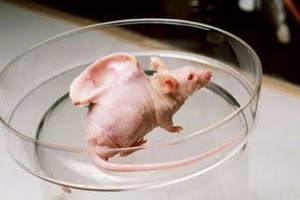BioTech and Art
Pattriana Perry
Week 6: Biotech and Art
This week's topic, biotechnology, in my opinion, was a controversial one. While I was going through lecture materials I continued to ask myself the question: is it ethical for us humans to conduct experiments and test on animals for the sake of scientific (and financial) gain? The question itself is hard to answer because, on one hand, I do advocate for our scientific advancement as A people, but on the other hand, I do not like the idea of harming animals in order to accomplish our goals.
I would agree with my professor’s assessment that much of biotechnology art is gearing towards creating shock value. Personally, I found the case study of OncoMouse to be rather disturbing. The OncoMouse is a mouse that has been genetically modified to be more susceptible to cancer, making it a better subject for cancer research. The mouse is of significant importance to human illness research. I believe the ultimate result of a closer cancer simulation could be a legitimate reason to justify the cruelty these animals have to suffer. However, I think there should be regulations and consistent guidelines on the ways animals are treated during tests. 20 mice should not have to suffer, if
five to ten mice are sufficient enough as a sample size for the project. I also believe some scientists like to genetically modify for the attention of it. For example, Stelarc’s ear on his arm has no real significance to advancing the human population. In this CNN interview https://www.cnn.com/style/article/stelarc-ear-arm-art/index.html, the hosts discussed how in the future, they wanted to put wifi in the genetically modified ear so that people can connect with it from all over the world. In my opinion, the "Wifi Ear" seems rather unnecessary because we already have pocket devices that can accomplish the same goal. However, if the scientist was trying to produce genetically modified ears for the sake of transplants or for research purposes (i.e. on the cure for the deaf population), then the matter would be different because the value that the project brings is of more significance.
Another topic that should be discussed is how we use genetic engineering in producing food. Although the procedure helps the environment in many ways, it also hurts us as a people. Personally, I do not like the genetically modified food. I think food should be grown naturally and left untouched. So many diseases and illnesses have arisen from genetically modified food. I truly believe that the human body is not made to consume GMOs.
References
CNN, Cable News Network, 13 Aug. 2015, www.cnn.com/style/article/stelarc-ear-arm-art/index.html.
“GMO Foods Have Not Proven Themselves Safe. Here's What to Do about It.” Newport Natural Health, 8 Dec. 2017, www.newportnaturalhealth.com/2013/07/gmos-the-pros-cons-of-genetically-modified-food/.
STELARC | EAR ON ARM, stelarc.org/?catID=20242.
“Vacanti Mouse.” Wikipedia, Wikimedia Foundation, 12 May 2018, en.wikipedia.org/wiki/Vacanti_mouse.
Week 6: Biotech and Art
 |
| Oncomouse |
I would agree with my professor’s assessment that much of biotechnology art is gearing towards creating shock value. Personally, I found the case study of OncoMouse to be rather disturbing. The OncoMouse is a mouse that has been genetically modified to be more susceptible to cancer, making it a better subject for cancer research. The mouse is of significant importance to human illness research. I believe the ultimate result of a closer cancer simulation could be a legitimate reason to justify the cruelty these animals have to suffer. However, I think there should be regulations and consistent guidelines on the ways animals are treated during tests. 20 mice should not have to suffer, if
five to ten mice are sufficient enough as a sample size for the project. I also believe some scientists like to genetically modify for the attention of it. For example, Stelarc’s ear on his arm has no real significance to advancing the human population. In this CNN interview https://www.cnn.com/style/article/stelarc-ear-arm-art/index.html, the hosts discussed how in the future, they wanted to put wifi in the genetically modified ear so that people can connect with it from all over the world. In my opinion, the "Wifi Ear" seems rather unnecessary because we already have pocket devices that can accomplish the same goal. However, if the scientist was trying to produce genetically modified ears for the sake of transplants or for research purposes (i.e. on the cure for the deaf population), then the matter would be different because the value that the project brings is of more significance.
Another topic that should be discussed is how we use genetic engineering in producing food. Although the procedure helps the environment in many ways, it also hurts us as a people. Personally, I do not like the genetically modified food. I think food should be grown naturally and left untouched. So many diseases and illnesses have arisen from genetically modified food. I truly believe that the human body is not made to consume GMOs.
References
CNN, Cable News Network, 13 Aug. 2015, www.cnn.com/style/article/stelarc-ear-arm-art/index.html.
“GMO Foods Have Not Proven Themselves Safe. Here's What to Do about It.” Newport Natural Health, 8 Dec. 2017, www.newportnaturalhealth.com/2013/07/gmos-the-pros-cons-of-genetically-modified-food/.
STELARC | EAR ON ARM, stelarc.org/?catID=20242.
“Vacanti Mouse.” Wikipedia, Wikimedia Foundation, 12 May 2018, en.wikipedia.org/wiki/Vacanti_mouse.
Vesna, Victoria. "BioArt Pt. 3." YouTube. YouTube. Web. 9 May 2015. <https://www.youtube.com/watch?list=PL9DBF43664EAC8BC7&v=3EpD3np1S2g>.


Comments
Post a Comment